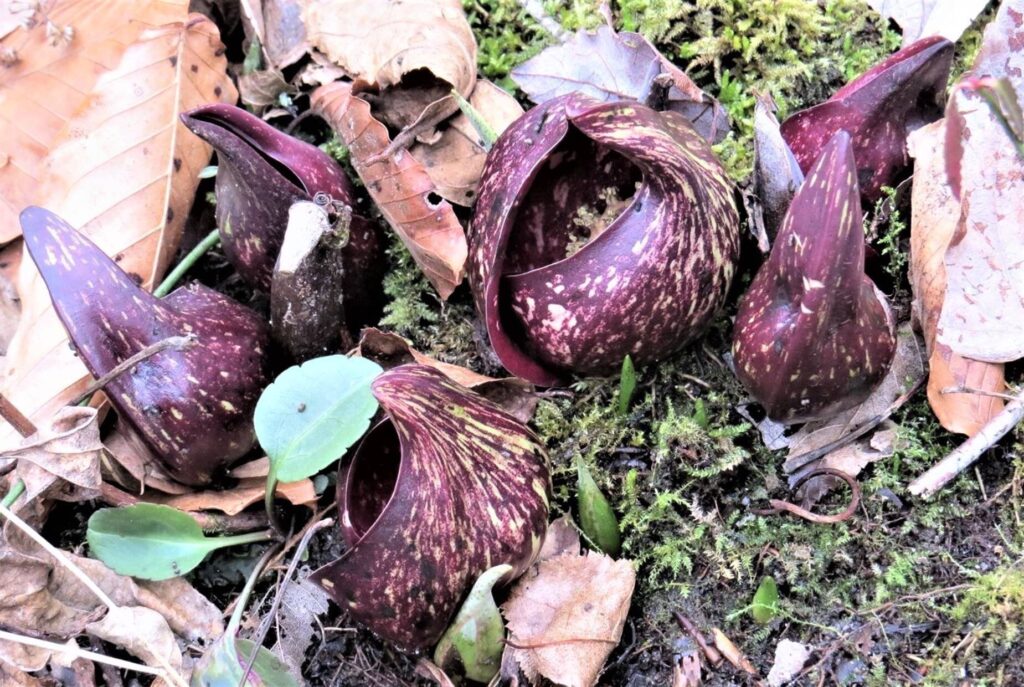There should be a national skunk cabbage day. Skunk cabbage is a wonderful native plant, first to bloom after the witch hazel, the silver maple, and the crocus, as much a symbol of woodland spring as the returning robins. This ancient, lovely and mysterious guardian of the wetlands is a plant about which many lies are told.
Common wisdom is that skunk cabbage is a stinky, ugly trash plant. Wrong. I have read on www.centralcoastflowermarkets.com.au that the smell comes only from the leaves that only unfold after the flowers are done but that the smell’s purpose is to attract pollinating insects. Not possible. It is said that you can eat raw skunk cabbage leaves after boiling; other reports indicate that you’d do better to invite an actual skunk into the kitchen because, then, at least the skunk would (possibly) enjoy the process.
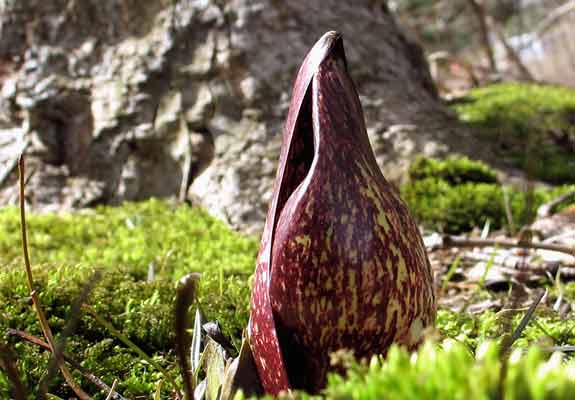
FAMILY:
Our native eastern skunk cabbage, Symplocarpus foetidus, is in the Arum family (Araceae), like the native jack-in-the-pulpit, and the tropical calla lily. The first interesting think about skunk cabbage is that even though it is as common as the mud in which it grows from Southern Canada to Northern Georgia, there’s only one species of it. It is so suited to its environment that part of the clan has not evolved into a genetically separate species. (The yellow-spathe western skunk cabbage, Lysichitum americanum, is also in the Arum family but different genus, so it is a cousin, not a sibling, and has different qualities.) Tropical Arum cousins that you might be harboring at home include philodendron, dieffenbachia (dumbcane), and aglaonema (Chinese evergreen).
IMMORTAL?:
Eastern skunk cabbage has such an amazing survival strategy that botanists theorize that the plant’s central rhizome could live for at least thousand of years, if not indefinitely. Specimens several hundred years old have been found. It is believed that the “limiting factor” for the life of a skunk cabbage is that it requires a year-round muddy bed, and, after hundreds of years, swampy places tend to dry up as the accumulation of decomposing plant litter raises the ground level. (Too bad the same can’t be said from most Arum houseplants – they’re tough but not nearly immortal).

SEEDS:
Eastern skunk cabbage doesn’t appear to be able to spread from the roots; so to make new plant colonies, it needs to make seeds. So, we’ll start there. The hard, pea-size seeds ripen in late summer, and drop into the mud. Some are carried away by animals or floods, the rest either die or germinate in place.
CONTRACTILE ROOTS:
Most plants are doomed to live (or die) exactly where and how the seed falls but the eastern skunk cabbage is blessed with a mobility device called “contractile roots”. The roots grow downward, then contract, pulling the plant’s crown (a thick underground stem called a “rhizome”) deeper into the mud. Each year, the plant digs itself deeper into the earth and extends its anchor-roots farther down. The young plants only have a few leaves: the very old ones, many. You generally can’t see the plant’s leaf or flower stems because they’ve been pulled underground. The roots of a mature plant are said to be so massive that trying to dig them out is a complete waste of time.
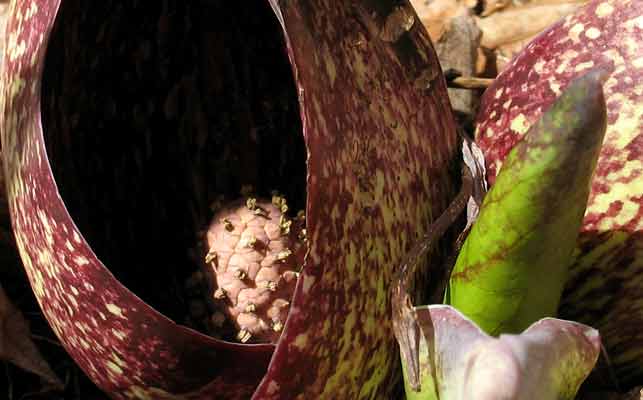
ENVIRONMENT:
Eastern skunk cabbage want muddy roots all year round; they’ll die in places that get too dry in summer. Conversely, while they love romping in the spring floods with water up to their noses, they don’t like having their crown under water all year. Thus, they are an edge-of-wetlands plant – and a clear sign to the hiker to stay back or risk damaging the fragile wetlands community, as well as bruising the skunk cabbage’s leaves and getting a nose full of a reek alternatively described as like a raw onion only more so, a skunk or rotting meat. While the smell warns animals that the leaves are too high in unpleasant compounds to be edible, it also warns the human invader to back off the wetlands.
FLOWER:
Eastern skunk cabbage, like most Arums, has a hood surrounding the flower stalk made from a modified leaf. The hood is called a “spathe”. Inside the hood is a flower stalk, called a “spadix”, which is covered with tiny, light-colored flowers with no petals. Since the hood never opens much, you have to peek inside to see the flowers. The flowers are said to be in “bloom” when the stamens have grown above the tiny flowers and are covered with yellow pollen.
Actually, the botanists say that the female flower parts (“pistils” or pollen receivers) bloom first before the male parts (“stamen” or pollen makers). In addition, the flowers bloom from the top of the stalk down. Thus, when the first female flower parts are in bloom, they can’t be pollinated from the same plant since none of the male pollen-bearers are blooming yet. What the plant ideally will get is cross-pollination from an earlier-blooming (and stronger?) plant. As we seen time and again, many plants insist on cross pollination to keep the species strong. The eastern skunk cabbage, though, is very smart. What if there’s no other plant or no other earlier blooming plant around? It appears that if all else fails, the eastern skunk cabbage should be able to self-pollinate later in the season. (I haven’t seen this confirmed with a biological study but there very well may be one).
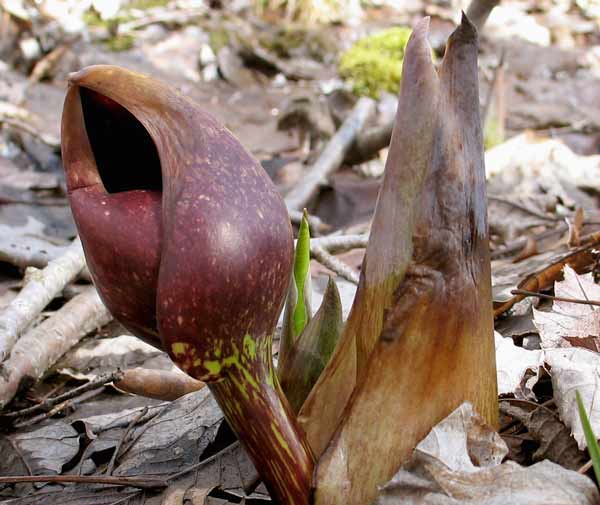
SPRING RITUAL:
To get a head start in spring, before the trees leaf out and shade the ground, the eastern skunk cabbage’s flower-to-be forms in the summer in the middle of the plant’s crown. Look down between the leaves, the round nub of the spathe is there, curled and waiting. Also made-ahead are the leaf cones. By early winter, you’ll often see next year’s cone-shaped furl of leaves poked up next to next year’s spathe, ready and set, just waiting for the “go” signal.
Once the days lengthen enough to say that spring might come someday, the skunk cabbage starts moving, literally. First, the spathe rises so fast that the heat thrown off by its growth can melt surrounding ice and snow. Technically, the process is called “respiration”. (The heat is produced by burning oxidizing carbs stored since last summer in the rhizome – same as when you exercise, assuming that you do, only you don’t have a rhizome to keep your fat out of sight.) The eastern skunk cabbage’s ability to create heat, and then hold the heat in inside the spathe is legendary among botanists.
Apparently, the plant actual can keep the tiny “room” inside the spathe at about 70F for a period of about 2 weeks while the plant is in active growth. Somehow the plant senses temperature drop and speeds up respiration. The theory is that the heat, plus a faint carrion odor, attracts pollinators, particularly flies. It certainly does result in the early-waking insects such as small flies, honey bees, gnats and spiders having a warm place to go at night. Some say that the attracted insects drown in water accumulated in the base of the spathe and then provide nutrients for the plant. There are many native bog carrion-consuming plants but the weight of authority seems to be that the skunk cabbage is not first and foremost an insect-trapper.
The above-ground parts of the skunk cabbage, being a very fast grower, are made mostly of water and air, with very little of the fibrous cellulose that stiffens woodier plants. The resulting air pockets in the spathe’s walls make it a good insulator to hold the heat, and the wall’s dark color helps absorb solar radiation. In addition, the shape of the spathe creates a vortex so that cold air flows in the wide opening toward the bottom of the spathe, warms and rises out the narrow top opening. This draws insects in at the bottom and releases insect-attracting odor out the top.
LEAVES:
It is often said that the leaves do not unfurl until flowering has finished. However, it is probably more accurate to say that the leaves start unfurling once the outside temperature is consistently warm enough to protect the new leaves from frost damage. The furled leaf cone, made with last summer’s sun and water, contains all of the plant’s leaves for the season. The plant, basically, just needs to unfold the package and inflate the leaf cells with air and water. Accordingly, the leaves quickly reach massive proportions – up to 3 feet long. Again, to grow this fast, the plant uses mostly water and air. Hence the need to grow in a swampy area where there’s plenty of fresh water in during the early growing season.
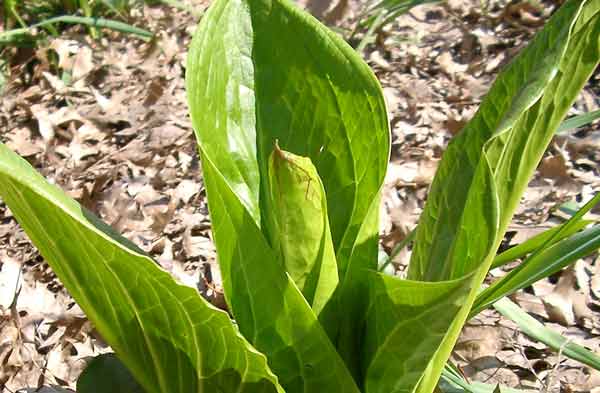
This year, take the time to check out the iris-like spiraling pattern of the opening leaves. The leaves are an attractive green anyway and the physical arrangement makes them even nicer. But look fast. Skunk cabbage leaves lack the thick, waxy skin (“cuticle”) that most plants use to keep in moisture. Consequently, skunk cabbage are constantly sucking water from the ground, up the stems, and through the leaves, then transpiring the water into the air. Most plants only transpire (sweat) when there’s too much relative water pressure in the leaves due to the surrounding air being too dry or the plant having sucked up too much water. But the skunk cabbage has no choice but to keep pumping water up and out. While you’re checking the leaves, see if you can sense a difference in the humidity near these plants.
But easy come is easy go. By early summer, the trees have leafed out and are shading the skunk cabbage’s leaves so much that the skunk cabbage’s leaves are no longer “profit centers” for the plant. The leaves no longer get enough sun to produce more food than they use, so the plant cuts them loose. It walls off the capillaries that once gave the leaves food and nutrients from the ground in return for food manufactured by the leaves using chlorophyll, air and sun. As soon as the water source is lost, because the leaves can not stop transpiring, the leaves deflate just as rapidly as they inflated in the spring. Small holes appear; the leaves droop. The next thing you know, there’s just a slimy, black smudge left on the ground, like the Wicked Witch of the East.
FRUIT:
The eastern skunk cabbage spends mid-summer, in the cool moist shade of the tree canopy, sucking whatever energy’s left out of the deteriorating leaves and making the leaves and spathes for next year. It’s also ripening the fruit made by the pollinated flowers on the spadix. By late summer, this year’s spathe is long gone. The fruit clustered along the spadix, now open to the air but still just above ground level, have turned the dark red to black. The fruit will either fall as the spadix itself disintegrates or will by eaten by birds and furry critters.
USE:
Skunk cabbage obviously pulls its weight in the eco-chain by providing early-spring board and room for the pollinators, anchoring the soil against erosion, keeping hikers out of the wetlands, and enthralling botanists. In addition, a few animals are not as bothered by the calcium oxalate crystals in the leaves, and other plant parts as we are. While few humans die from ingesting Arum plant substances, few choose to repeat the experience of a “strong inflammatory reaction in the mouth and esophagus” (means: it burns a whole lot!). Black bears, wild turkey, and Canada geese are reported to be among the animals brave enough to eat the young leaves, buds or roots. (As far as I can tell, deer and rabbit won’t touch it.) The seeds are said to be eaten by squirrels (of course), other wood rodents, ring necked pheasants, ruffed grouse and bobwhite.
Native Americans did use the leaves and roots for food and medicine. Apparently, the trick is to dry the stuff for at least 6-months before use. There are a bunch of other in’s and out’s to human consumption, so don’t try it without reading up thoroughly first. Lastly, I’ve read that the smell from the raw crushed summer leaves will ward off insects, useful, though, only if you’re not warded-off first.
More to read: Choosing the Right Funeral Flowers to Honour a Life

